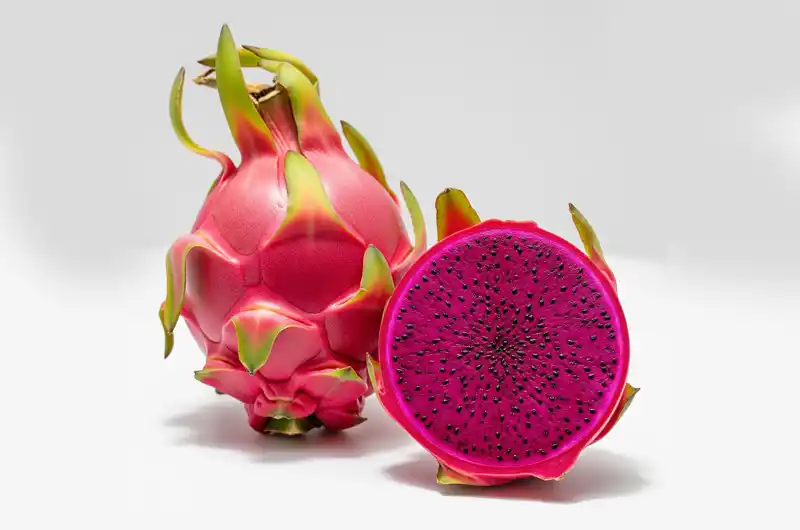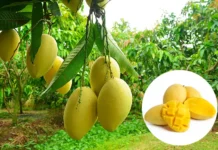1. What is Red Dragon Fruit (Red Pitaya) and What Does It Look Like?
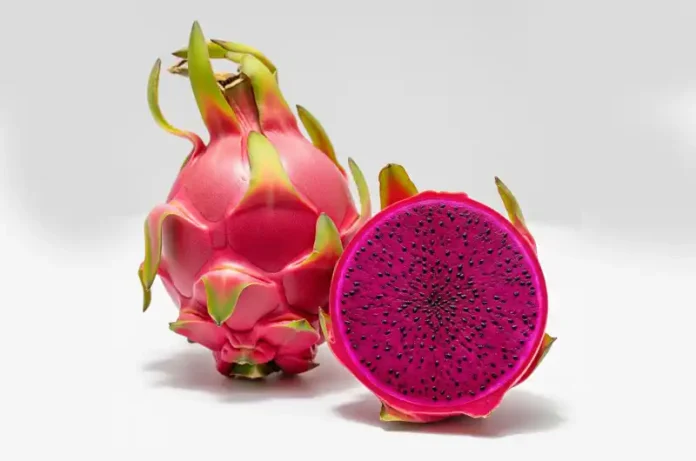
Essential Red Dragon Fruit Info: Red dragon fruit, also known by its alternative name red pitaya, is the visually stunning fruit of a night-blooming cactus, typically of the Hylocereus costaricensis or Selenicereus costaricensis species (Source: Botanical classification literature, e.g., Britton & Rose). Originally from Central and South America, its most striking characteristic is its bright pink or reddish skin with green-tipped scales. Inside, you’ll find deep red or magenta flesh speckled with tiny, edible black seeds, offering a mildly sweet and refreshing taste often compared to a kiwi-pear hybrid.
2. Nutrition Facts & Key Vitamins
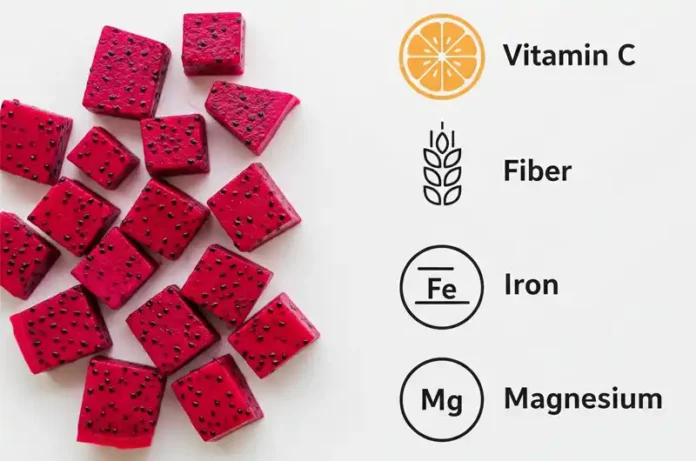
This section provides key Red Dragon Fruit Info regarding its nutritional value. Widely regarded as a “superfood” for its nutrient density and antioxidant content (Source: Health and nutrition focused publications, e.g., articles from Cleveland Clinic or Healthline), this fascinating fruit is not only delicious but also impressively low in calories. A typical serving provides a significant boost of Vitamin C (essential for a strong immune system), a good amount of dietary fiber (crucial for digestive health), and important minerals like iron and magnesium (Source: USDA FoodData Central or similar nutritional databases).
3. Antioxidant Power: Red Dragon Fruit’s Health Boost from Betacyanins
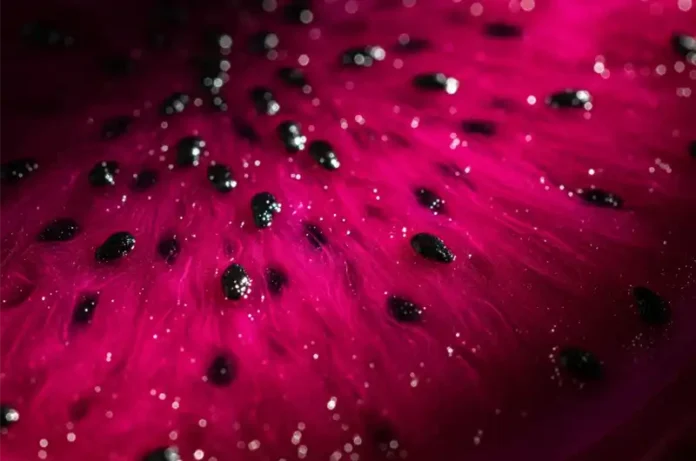
The deep red-magenta hue of red dragon fruit isn’t just for show; it signals a high concentration of powerful antioxidants, particularly betacyanins (Source: Peer-reviewed studies on fruit pigments and antioxidant capacity, e.g., Journal of Agricultural and Food Chemistry). These compounds, along with other polyphenols, help your body combat oxidative stress caused by free radicals, potentially reducing the risk of chronic diseases and contributing to overall cellular health (Source: General research on antioxidants and health). This makes red dragon fruit a true health booster.
4. Red Dragon Fruit Info: Health Benefits

Incorporating red dragon fruit into your diet offers a range of potential health advantages. Beyond its antioxidant prowess, its high Vitamin C content bolsters your immune system (Source: Nutritional science literature on Vitamin C). The dietary fiber aids digestion, promotes gut health (Source: Research on dietary fiber and digestive health), and can help with weight management by making you feel fuller. Furthermore, some studies suggest compounds in dragon fruit may contribute to better heart health and blood sugar regulation (Source: Specific studies on dragon fruit and cardiovascular/metabolic health). Remember to consult a healthcare professional for personalized medical advice.
5. How to Choose Ripe Red Dragon Fruit at the Store

How to choose the perfect red dragon fruit. Look for fruit with bright, even, and vibrant pink or red skin. It should yield slightly to gentle pressure, similar to a ripe avocado or kiwi—not too soft (which means overripe) or very firm (underripe). The green-tipped “leaves” or scales on the fruit should look fresh and plump, not dry, brown, or brittle. Avoid fruits with significant bruising, blemishes, or signs of mold.
6. Best Way to Store Red Dragon Fruit for Maximum Freshness
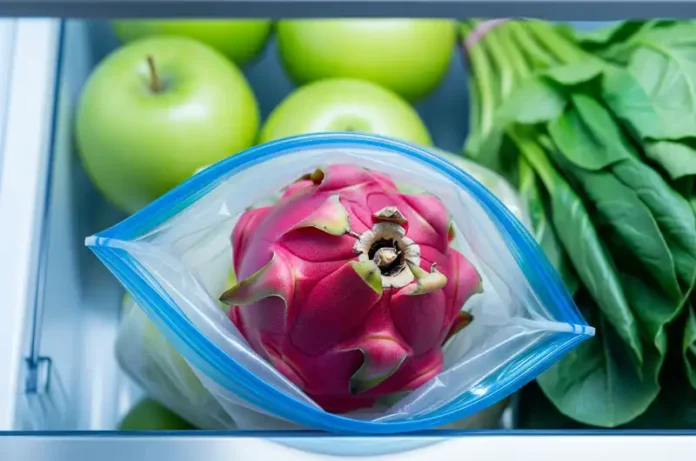
To keep your red dragon fruit fresh for as long as possible, proper storage is key. If you plan to eat it within a day or two, provided it’s whole and uncut, you can store it on the counter at room temperature. For longer storage (up to a week, sometimes even longer), the best way to store red dragon fruit is to place it in a sealed plastic bag in the crisper drawer of your refrigerator. This helps retain moisture and prevent it from absorbing other odors.
7. How to Eat Red Dragon Fruit: Simple & Tasty Ideas
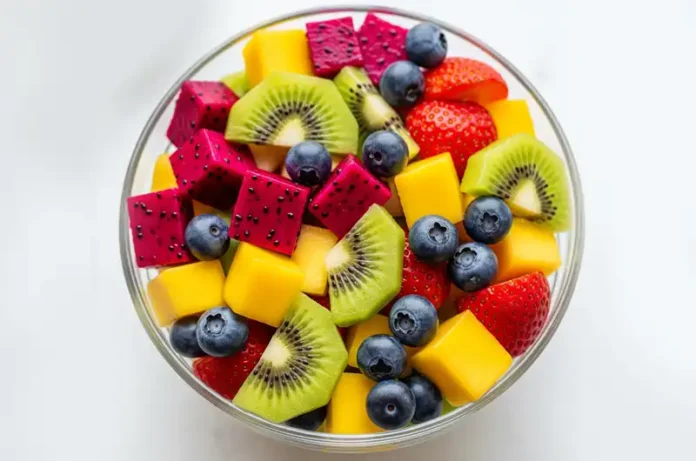
Here’s how to eat red dragon fruit in several delicious ways. The most straightforward method is to cut the fruit in half lengthwise and use a spoon to scoop out the vibrant flesh. Beyond eating it plain, diced red dragon fruit is a fantastic addition to fruit salads or as a colorful topping for yogurt and smoothie bowls. For a refreshing drink, blend it into smoothies. It can also be transformed into a delightful sorbet or used as an eye-catching garnish for desserts and cocktails. Experiment with these ideas to discover your preferred way to savor it!
Read More: Easy Red Dragon Fruit Bread Recipe
8. Can red dragon fruit be grown at home?

If you’re an avid gardener with a warm climate (typically USDA hardiness zones 10-11), growing red dragon fruit (pitaya cactus) can be a rewarding experience. This vining cactus needs plenty of sunlight and a sturdy trellis or support structure to climb. Use well-draining soil rich in organic matter. While it can be grown in large pots in cooler regions and brought indoors during winter, fruiting might be more challenging. Ensure regular watering but avoid waterlogged conditions.
9. Red vs. White Dragon Fruit: Taste & Nutrition Differences Explained
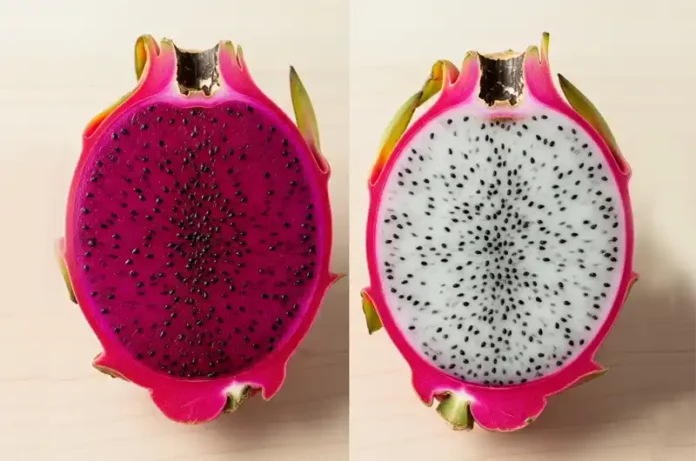
The most obvious difference between red and white dragon fruit is the flesh color. But what about taste and nutrition? While both are mildly sweet, some find red dragon fruit to be slightly sweeter or to have a more pronounced berry-like flavor. Nutritionally, red dragon fruit generally takes the lead due to its higher levels of antioxidants, specifically the betacyanins responsible for its rich red hue (Source: Comparative studies on antioxidant compounds in different Hylocereus species, often found in journals like Food Chemistry or Molecules). White dragon fruit is still nutritious but lacks these specific potent pigments in its flesh.
10. The Mystical ‘Queen of the Night’: Dragon Fruit’s Spectacular Flower

The dragon fruit plant’s flower is quite impressive. Often called the “Queen of the Night” or “Moonflower,” this large, white, and fragrant flower has a special blooming habit: it opens for just one night, typically in the evening, and is gone by morning. Its brief appearance is quite beautiful.
11. From Central America to Global Favorite
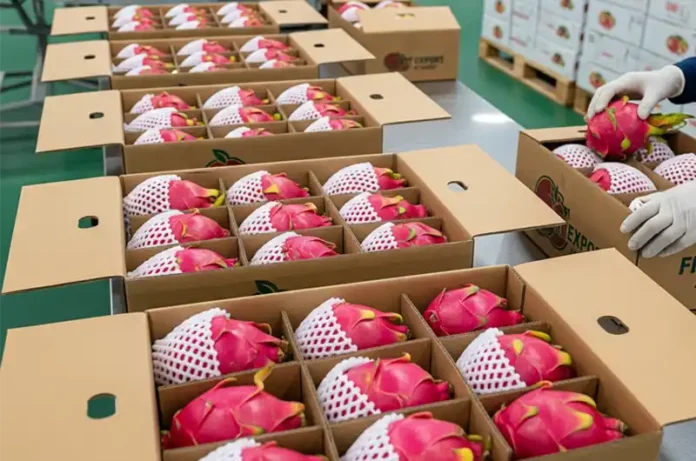
While originating in the tropical and subtropical regions of Central and South America (Source: Horticultural and botanical literature on fruit origins), red dragon fruit has embarked on a remarkable journey to become a beloved fruit cultivated and enjoyed across the globe. Its adaptability, unique appearance, and appealing taste have made it a popular crop in Southeast Asia (like Vietnam and Thailand), Australia, Israel, and parts of the United States, truly making it a global favorite (Source: Agricultural reports and global trade information).
12. Why Is It Called ‘Dragon Fruit’? The Story Behind Its Unique Name
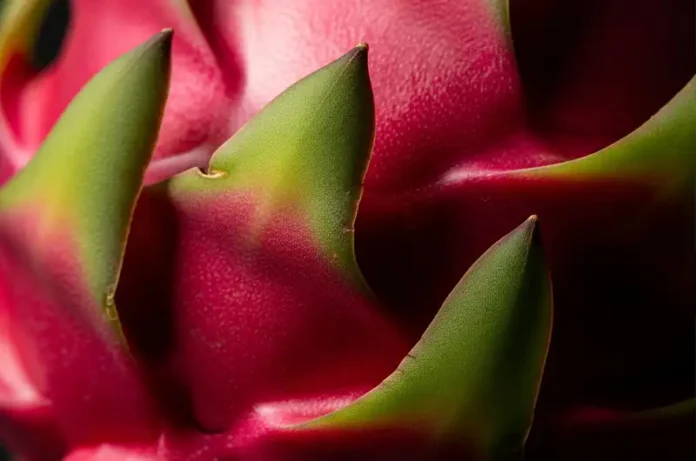
Ever wondered why it’s called ‘dragon fruit’? The name comes from its unique, leather-like skin and the prominent, flame-like or scaly spikes (correctly termed bracts) that adorn its exterior. This appearance reminded people of the scales of a mythical dragon, leading to its fascinating and memorable moniker that perfectly matches its fantastical look.
13. FAQ: What does red dragon fruit taste like?
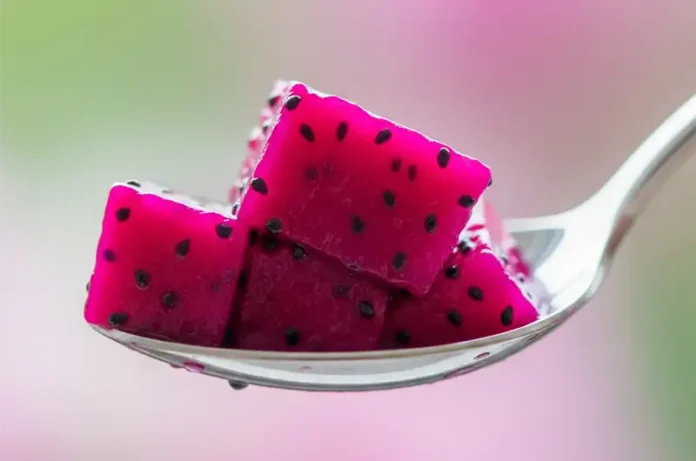
This is a common question when seeking Red Dragon Fruit Info. Red dragon fruit generally has a mildly sweet and refreshing taste. Many people describe its flavor profile as a subtle blend of kiwi and pear, with a hint of berry notes in some varieties. The texture is similar to a ripe kiwifruit or watermelon—soft, aqueous, and interspersed with tiny, crunchy, edible black seeds.
14. FAQ: Is red dragon fruit really good for you?
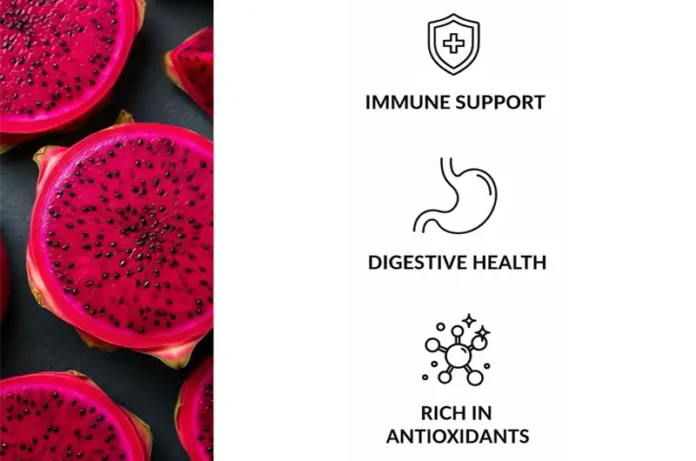
Yes, red dragon fruit is definitely good for you. It’s a low-calorie fruit that’s packed with essential nutrients (Source: USDA FoodData Central or similar nutritional databases). It’s an excellent source of immune-boosting Vitamin C, digestion-aiding fiber, and cell-protecting antioxidants like betacyanins (Source: Peer-reviewed studies on fruit pigments and antioxidant capacity). Enjoying it is a tasty way to support your overall health.
15. FAQ: How do you know when red dragon fruit is perfectly ripe?
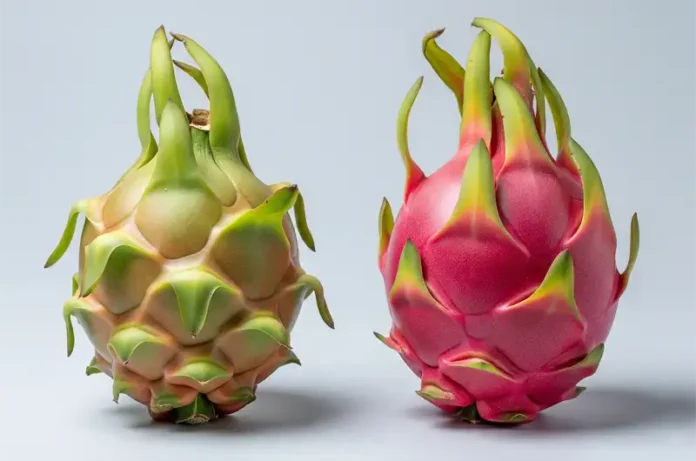
Knowing when red dragon fruit is ripe is key to enjoying its best flavor. Look for bright, evenly colored pink or red skin. Gently press the fruit; it should yield slightly to pressure, similar to a ripe avocado. The “scales” or “leaves” on the skin should still look relatively fresh and vibrant, not overly dry, brown, or brittle. Avoid rock-hard fruits (underripe) or those that are very mushy or bruised (overripe).
16. FAQ: Can you eat the skin of red dragon fruit?
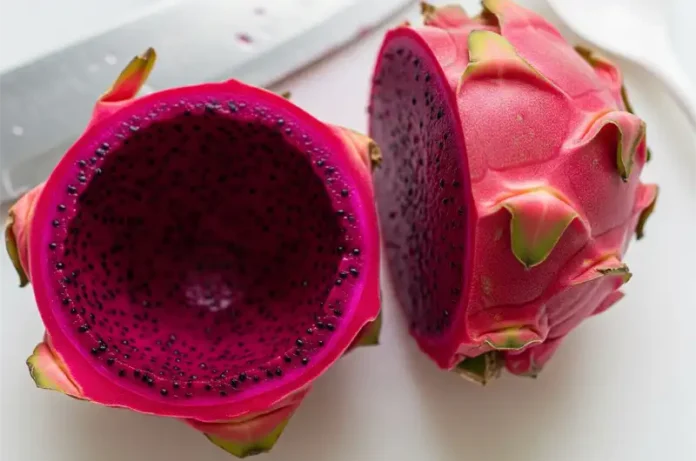
While the skin of red dragon fruit isn’t toxic, it is generally not eaten. It’s quite tough, leathery, and doesn’t have a pleasant taste or texture. The delicious, vibrant flesh inside is the part you’ll want to focus on enjoying. Compost the skin if you can!
17. FAQ: Where can I buy red dragon fruit easily?
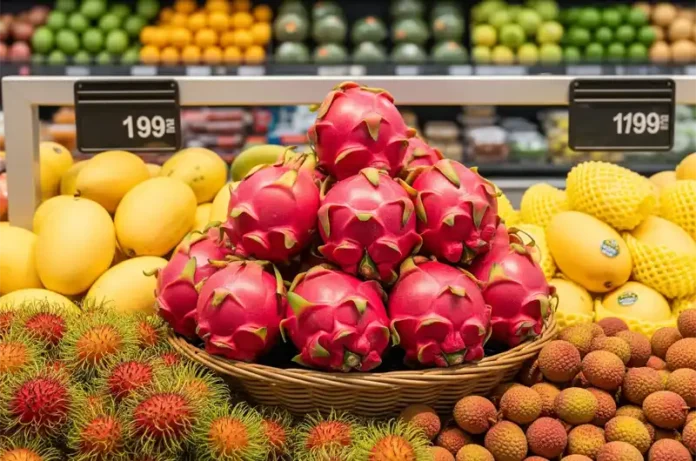
You can often buy red dragon fruit in the tropical fruit section of larger supermarkets and grocery stores. They are also commonly found at specialty food stores, Asian markets, and farmers’ markets, especially when in season (though imports make them available more widely year-round in many places). Look for them alongside or tropical fruits.

